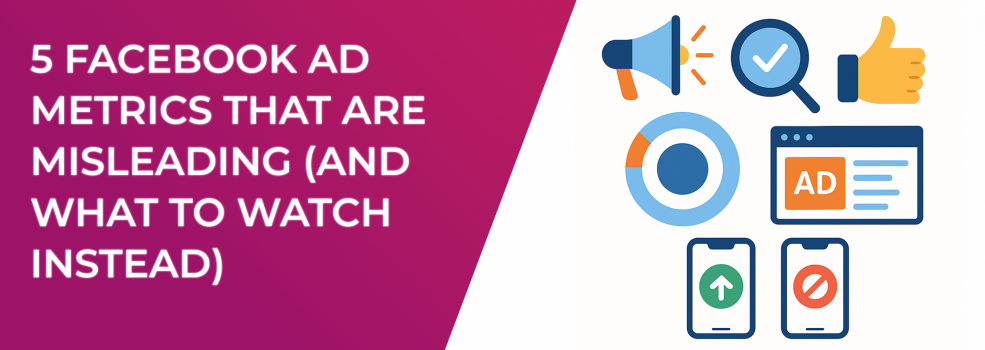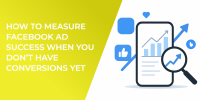Opening Ads Manager can feel like staring at a Las Vegas slot machine. Flashing numbers promise wins, yet your bank account might be telling a different story. Below are five common Facebook ad metrics that often mislead marketers, plus the performance indicators you should track to improve Facebook ad performance and drive profit.
1. Click-Through Rate (CTR)
Why it can fool you
A sky-high CTR usually measures curiosity, not buying intent. Accidental taps, bargain hunters, and even bots inflate clicks without adding revenue.
What to watch instead
-
Post-click conversion rate shows how many clicks actually become customers.
-
Cost per qualified lead (CPL) ties clicks to wallet outcomes so you see what each real lead costs.
Unsure what counts as a good CTR? Check the latest benchmarks in this CTR best-practice roundup.
If CTR rises but CPL doesn’t fall, tighten audience filters or adjust creative to screen out low-intent traffic.
2. Impressions and Reach
Why they are overrated
Gigantic impression and reach numbers look impressive, yet the same people may be seeing your ad ten times without taking action. If impression math still feels murky, see what Facebook ad impressions really mean—and how to act on them.
Big reach numbers lose value when the same people see your ad again and again.
What to watch instead
-
Unique CPM (uCPM) reveals how efficiently you reach fresh eyes rather than bombarding the same audience.
-
Incremental conversion lift from hold-out tests shows whether those impressions create new sales or just cannibalise organic demand.
Pair that with a quick primer on frequency capping to beat ad fatigue so you keep fresh eyes on every dollar.
Scale spend only when lift proves incremental revenue.
3. Cost Per Click (CPC)
Why cheap clicks can be expensive
A low CPC often means Facebook finds bargain inventory—but cheap clicks may land on placements that rarely convert, ballooning CPA. To keep cheap clicks from draining profit, follow these tactics for reducing Facebook ad costs without sacrificing performance.
What to watch instead
-
Cost per action (CPA) focuses on the event that pays the bills.
-
Return on ad spend (ROAS) links every dollar to revenue and underpins robust Facebook ad optimisation.
When CPC drops but ROAS flat-lines, test new targeting segments or exclude low-quality placements.
4. Quality, Engagement, and Conversion Rankings
Why the scores feel fuzzy
Meta’s rankings compare your ad against competitors chasing the same audience, so a “Below Average” badge doesn’t automatically mean the ad is unprofitable.
What to watch instead
-
Conversion ranking + CPA offers a reality check — if CPA meets your target, a middling ranking may not matter.
-
First-time impression ratio monitors creative fatigue by showing how many viewers see your ad for the first time.
Speeding through Meta’s learning phase also stabilises these rankings; here’s how to finish the Facebook learning phase quickly.
Profit beats popularity, an average ranking can still deliver stellar ROAS.
Refresh visuals and copy routinely to keep the ratio healthy while maintaining profitable CPAs.
5. On-Ad Engagement (Likes, Comments, Shares)
Why applause isn’t revenue
People love witty memes and snarky comments, but that buzz rarely translates into checkouts. If your posts are racking up comments but not customers, try these fixes for low-engagement Facebook ads. Engagement can lure audiences outside your target demographic, dragging down conversion rates.
What to watch instead
-
Purchase conversion rate or a robust lead-quality score ties reactions back to results.
-
Customer acquisition cost (CAC) vs. projected lifetime value (LTV) is the final word on whether an engaging ad is worth its budget.
If engagement spikes while CAC stalls, retune creative toward offers and testimonials that speak to buyers, not bystanders.
Bringing It All Together
Whenever you open a report, ask yourself:
-
Does this metric link directly to revenue or cost efficiency?
-
Can I act on it today?
-
Will improving it enhance overall Facebook ad performance?
By replacing vanity stats with outcome metrics like CPA, ROAS, and conversion lift, you stop chasing false positives and start building profitable, scalable campaigns. Keep familiar numbers like average click-through rate and average cost per click in view, but judge success only after they connect to the bottom line.
Master this mindset, and your next budget will be allocated with confidence and clarity.

